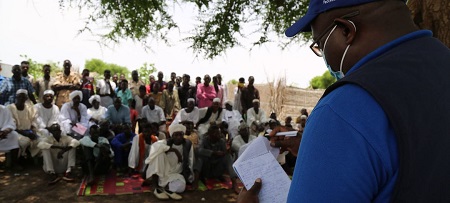Sudan: From Charity to Development

In transitional countries and contexts, one of the greatest challenges for civil society, in general, and nongovernmental organizations, in particular, is their corresponding development from charity and relief work in crises to more-mature development roles. That transition involves developing, developing into, and contributing to institutions that formulate and implement development policies.
That was the subject of HLRN’s recent project, twinning with its Sudanese local partner, Istidama Center for Land and Environmental Governance, on “Land governance toward durable solutions for resettlement of internally displaced persons (IDPs) in Sudan.” supported by the Global Land Tool Network (GLTN) through its Arab Land Initiative. HIC-HLRN seeks to support the outcomes and recommendations of this rapid assessment of the learning and capacity needs of IDPs and key local organizations working in humanitarian assistance to IDPs in Sudan.
One of these key outcomes, the issue of reparation, and its framework for victims of forced eviction and other “gross violations” of human rights as integral to the normative framework for both durable solutions and peace building, and support the transition of local CSOs organizations to develop roles beyond the current prescribed limits of delivering humanitarian services toward durable solutions for Sudan’s IDPs, as the funding arrangements for only emergency measures may not yet qualify as restitution or other forms of reparation.
According to the survey responses, 92 survey participants especially noted the needs, rights and interests of host communities and the national priority of peace building as integral to the durable solutions sought. While, the majority of the IDPs needing secure land tenure and adequate housing have been uprooted from their original rural locations due to conflict under the previous two decades of military government, and that context it requires that the local CSOs organizations are need to expand their vision and constructive activities beyond charity work, to fulfill their potential to assume roles in policy formulation and implementation in Sudan’s transition.
Participants also debated multiple definitions of, and approaches to justice, emphasizing restorative justice and the anticipated long process of transitional justice in Sudan. They expressed their concern that solutions be integrated to meet the development challenges of all Sudanese pursuing diverse means of livelihood, not least host communities in cases of IDP return and resettlement.
In this context, the establishment of a civil land observatory on a national scale, is an important and urgent matter, as it could provide a non-political, non-tribal and non-military advisory function that considers the multiple values and functions of land, including the New Urban Agenda’s commitment of states to ensure “the social function of land,” beyond land’s mere financialization as property.
Such a national land observatory’s “human right to land” approach could settle multiple interpretations of the Doha Peace Agreement’s references to “registered land” in Darfur. In the terms of the CESCR General Comment No. 26 on land, multiple forms of “legitimate tenure” would be considered, beyond only freehold possession. The introduction of a human rights approach to land could provide the needed technical support to the National Land Commission and the Darfur Land Commission, to provide explicit mandates, institutional structures, and administrative procedures to address the critical issue of land occupation in Darfur, South Kordofan, Blue Nile and elsewhere in Sudan, and explore alternatives to securing land tenure for the most-vulnerable groups.
Amid the HLRN-Istidama twinning project’s hopeful prospects of Sudanese civil organizations playing greater development and policy roles, all were reminded during the same period just how volatile land matters can be, even during a promised democratic transition and transitional justice processes. In October 2022, violent inter-tribal conflict reignited in Blue Nile State`s Wad al-Mahi locality and the Dam towns, where at least 70,000 people had reportedly been displaced within the state and beyond since mid-July.
Amid climate change, the heavy rain from May through September 2022 also brought flooding that affected around 349,000 people, destroyed at least 24,800 homes and damaged another 48,200 homes in 16 out of the 18 states. The IDPs camps, the locus of one of the world`s most-neglected crises, were inundated and suffered 146 fatalities and more than 122 people injured since the beginning of the rainy season in June. These developments underscore the neglect of this vulnerable population already undergoing human-made disaster of politicized ethnic conflict. Natural resources are being depleted around camps as a result of the relief-assistance gap. Meanwhile, disputes over land use in Darfur have had serious environmental consequences amid what has been labeled the “first climate change conflict,” which HLRN also covered in its 2022 World Habitat Day report from the Violation Database: In Pursuit of Climate Justice.
Photo: Meeting with project beneficiaries, Community-based Resolution Mechanisms and Peacebuilding Committees in al-Fadu, Assalaya Locality, East Darfur, Sudan. Source: UN News.
|